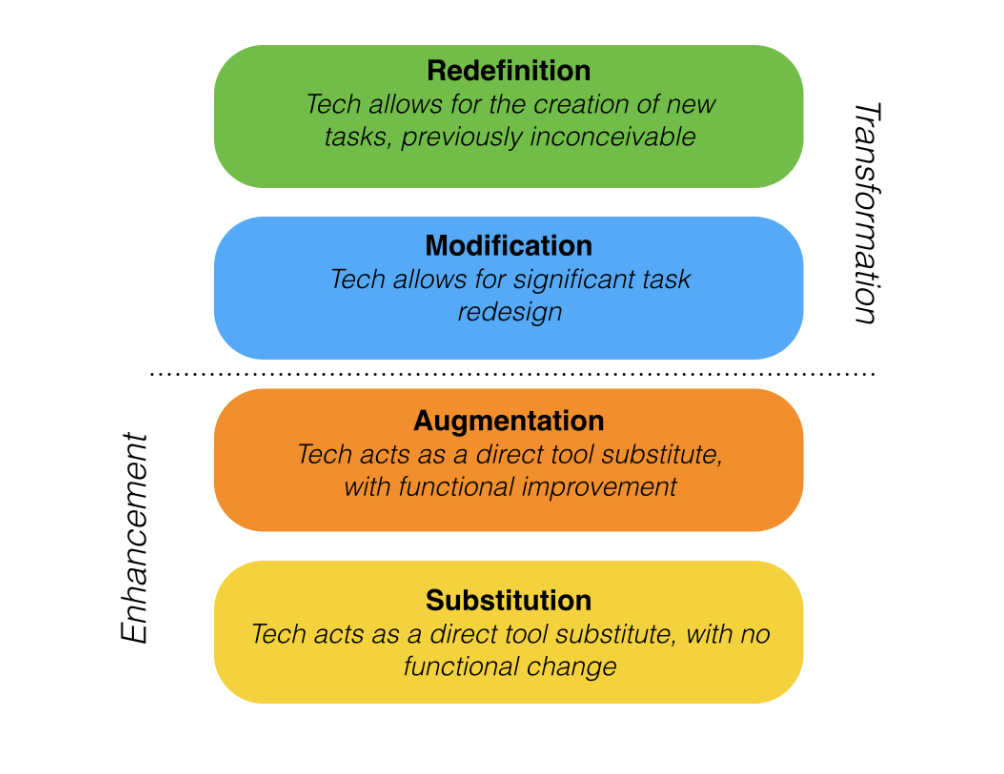Chapter 10: Choosing and using media in education
10.11 Assessing media affordances: the SAMR model

10.11.1 Exploiting the affordances of a medium
It has been noted in several of the preceding chapters (for example, Chapter 7, Section 4 and Chapter 8, Section 4,) that video technology can be used as a straight replacement for a face-to-face lecture by merely substituting the face-to-face delivery with online delivery. The mode of delivery has changed but not the pedagogy. The full affordances of the medium of video have not been exploited.
On the other hand, using video to show a documentary can bring powerful examples of situations to which can be applied the ideas and concepts covered in an academic course. A documentary thus has the potential to make better use of the affordances of video than recording a lecture because the learning experience from watching a documentary is different from watching a lecture; at the same time, using a documentary video will require a different approach to teaching than using a lecture and will probably have different outcomes. With the video lecture students will focus on comprehension and understanding; with the documentary the students’ focus will be on analysing and critiquing the material.
10.11.2 The SAMR model
A good way to assess whether a particular application of media or technology is making full use of the affordances of a medium is to apply the SAMR model developed by Dr. Ruben Puentedura, a technology consultant based in the USA.
Puentedura suggests four ‘levels’ of technology application in education:
- substitution: a direct tool substitute, with no functional change, for example, a video recording of a classroom lecture on water quality, made available for downloading by students; students are assessed on the content of the lecture by written exams at the end of the course.
- augmentation: a direct tool substitute, with functional improvement, for example, the video lecture is embedded in an LMS, and edited into four sections, with online multiple-choice questions at the end of each section for students to answer.
- modification: significant task redesign, for example, the instructor provides video recordings of water being tested, and asks students to analyse each of the recordings in terms of the principles taught in the course in the form of essay-type questions that are assessed.
- redefinition: creation of new tasks, inconceivable without the use of technology, for example, the instructor provides readings and online guidance through the LMS, and students are asked to record with their mobile phones how they selected samples of water for testing quality, and integrate their findings and analysis in the form of an e-portfolio of their work.
In the first two levels, substitution and augmentation, video is used to enhance the method of teaching but it is only where video is used in the final two stages, modification and redefinition, that teaching is actually transformed. Significantly, Puentedura links the modification and transformation levels to the development of Bloom’s higher order ’21st century’ skills such as analysis, evaluation and creativity (Puentedura, 2014). For a more detailed description of the model and how it works, see the video: Introduction to the SAMR model.
10.11.3 Strengths and limitations of the model
First, I was unable to find any research that validated this model. It has a powerful feel of common sense behind it, but it would be good to see it more empirically validated, although there are many examples of its actual use, particularly in teacher education in the k-12 sector (you can find some examples collected by Kelly Walsh here. For a more critical response to the SAMR model, see Linderoth, 2013).
Second, while the model is a useful means of evaluating whether a use of technology merely enhances or radically changes teaching, it doesn’t help much with the hard part, and that is imagining the transformative ways in which a technology could be used in the first place. Nevertheless it is a good heuristic device to get you to think about the best way to use technology in teaching, and perhaps more importantly, how to assess the potential in your choice of technology.
Third, there will be situations where substitution and augmentation will still be a perfectly justifiable use of technology, for instance for students with disabilities, or to increase accessibility to learning materials.
On balance, it is a very useful model by which an instructor can evaluate a potential or actual use of technology. In particular it focuses on the way students will need to interact with the technology and the ways technology can be used to assist the development of 21st century skills.
References
Linderoth, J. (2013) Open letter to Dr. Ruben Puentedura Spelvetenskapliga betraktelser, 17 October
Puentedura, R. (2014) SAMR and Bloom’s Taxonomy: Assembling the Puzzle common sense education, September 24
Activity 10.11: Assessing the SAMR model
- If you are using any technology in your teaching, where does it fit in the SAMR framework in comparison with in-person teacher-student interaction? What could you change to make the technology ‘move up the ladder’?
- Do you have to exploit fully the affordances of a medium? If so, why?
For feedback on this activity, click on the podcast below

